

Spring stormApril 6, 2012
We arrived at the drill site on April 3 and shortly there after were met by a large spring storm (Article on storm). We had 30 m/s and 8-10 m high waves. We started seeing WOW on all of the drilling progress updates. Thought it was an exclamation about how big the storm was, turns out it just means "waiting on weather". Really it wasn't that bad on the ship. Some people got seasick on the 4th, thanks to medication I was not among them but I was a little queasy. We weren't allowed out on deck and the elevators and gym were closed. It was pretty cool view from the port window though. There were a lot of white caps and sometimes I could see the separate crests and troughs of the waves passing by the ship but videos and pictures aren't nearly as impressive as the real thing. The storm ended yesterday and we are progressing towards starting to drill!
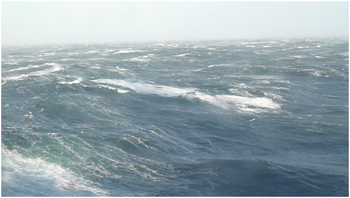
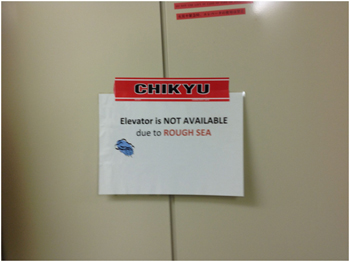


WOWApril 5, 2012
Chikyu arrived on the JFAST drill site yesterday and was greeted by typhoon-strength (30m/s) winds whipping up the Pacific into a surging mass of 8-10m high waves. The same storm has shut down airports on the mainland and left many stranded. Tasks scheduled for the drilling preparations have been delayed because the ship is rolling around too much. Fortunately the cruise here from Shimizu went well and we arrived ahead of schedule so the storm has not set things back too badly so far.
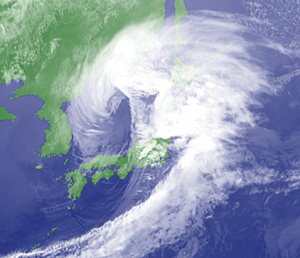
This satellite image shows the extent of the storm we are currently experiencing
(Tuesday, April 3, 2012, Japan Meteorological Agency)
Even though Chikyu is huge, being on board in this weather feels like being in an airplane in severe turbulence. Except the storm has been raging for 24 hours! Walking in straight line is a distant memory and all of the outside deck areas are currently off limits thanks to the wind. The science party has had a tough introduction to the high seas, even the old hands are impressed at the longevity of this storm! Some people seem to have been completely unaffected, but there are definitely some green faces around, mine included.
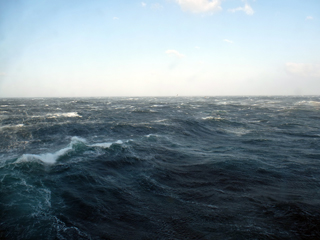
The view from the porthole. 8 ? 10 m waves are crashing constantly against the side of the boat and the swell is causing the boat to roll and rock significantly. Hopefully it will blow over soon!
Despite the conditions, the science party continues to work hard to prepare for the drilling phase of the expedition. We are in an intense planning and training phase, working around the clock. As a group we are finalizing the design of the experiment here, deciding on the optimum layout for the drill holes. Every scientist will have a specific role once the operation is underway. Each person needs to become intimate with the tools they will be using, but it is fantastic how everyone is working together and sharing experience and ideas for improving on established methods, techniques and technologies. As a newcomer to the ocean drilling program, I feel lucky to be able to work and learn from the collection of world experts that make up the science team. The learning curve is steep but it the enthusiasm of the group is amazing, and the sense of working towards a common goal is inspiring.
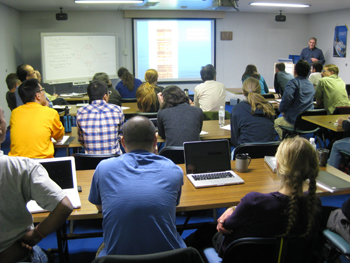
Legendary scientist Casey Moore explains how faults are identified in drill holes from logging data.
The first stages of the drilling operation will be incredibly exciting: an underwater TV will be lowered 7km down to the sea floor to peer around and scope out the site. The engineers will try to find two sites to locate the drill head amongst the rocks. Will there be any friendly crabs to help out? Who knows, but one thing for sure is I can’t wait for the drilling to begin!
For now the plan is to Wait Out the Weather.


What is Namazu?April 4, 2012
According to Japanese mythology Namazu is a giant catfish that lives in the mud beneath the islands of Japan. Namazu is restrained by the god Kashima but when Kashima lets down his guard Namazu moves and the result is an earthquake. On March 11, 2011 during the Tohoku earthquake Namazu moved a lot.
Now one year later IODP expedition 343 - Japan Trench Fast Earthquake Drilling Project (JFAST) has set off to study the Tohoku subduction zone on the deep sea scientific drilling vessel Chikyu. The water depth where we will be drilling is 6910 meters below sea level. Chikyu will drill as much as 1000 meters below the seafloor to reach the fault zone. Drilling has never been done to such depths before. We will measure fault zone physical properties, recover material from the fault zone, and record the temperature anomaly that resulted from frictional slip during the Tohoku Earthquake. From this information we will learn more about the fault zone and why it slipped.
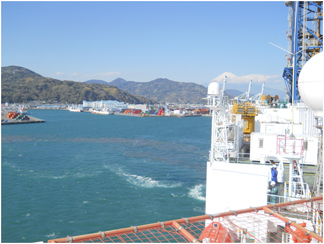
Leaving land behind and heading to the drill site located off the Oshika Peninsula.
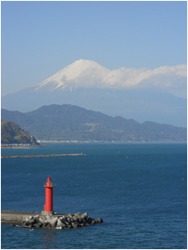
View of Mount Fuji from the heli deck


Arriving at the borehole siteApril 4, 2012
This morning at 8 am, after 41 hours of transit, we arrived at the location of our first borehole. I was able to track our route with a hand-held GPS from the port at Shimizu to our current location at JFAST 3, located about 250 km east of Sendai. It was nice to be able to watch our progress on the GPS map. We had little way of knowing our position otherwise because we were far from shore and could only see the ocean for miles.
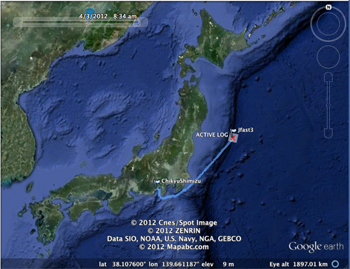
Map of our route from Shimizu to the borehole site.
This is my first time at sea, and I wasn't sure what to expect in terms of sea sickness. For the first day, the motion of the boat was so slight that I had a hard time discerning weather or not it was even real. It's a very odd effect because you have no stationary reference frame inside the boat. It kind of feels like you are in a flight simulator at an amusement park. Your body feels the change in acceleration with every wave, but because everything in the room is moving with you, your mind does not know how to process the motion. It can be very disorienting until you get used to it, and I have stumbled off my feet a couple of times in big waves. It is actually is much easier to handle when you are out on deck or looking out of a window and can see the horizon.
Unfortunately, some bad weather has moved in today and we cannot start operations until the waves calm down. As of this afternoon there were swells of ~5m, and it is likely that they will be up to 10-15m by night. Already the boat is rocking with quite a fervor, and the drilling derrick (tower) is making an eerie, grinding, metallic noise as it compensates for the ship's movement. Luckily, we've had two days to get somewhat acclimatized to the constant motion. In addition, the Chikyu is a very large boat, and is quite stable in comparison to smaller vessels. But I think we will all find out tonight just how good our "sea legs" are.
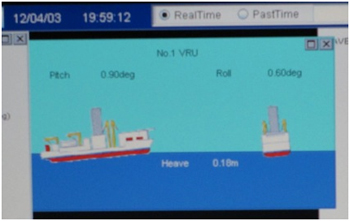
This computer monitors the pitch and roll of the ship.
As we prepare to begin drilling operations, the scientists on board have been taking part in many discussions about the project, how we want to position the boreholes, and what data we can use to definitively locate the fault zone. In addition to scientific discussions, we were able to get a tour of the drilling operations portions of the ship. The engineers, drillers, and mechanics have tough jobs and it is because of their work that we can even hope to be able to examine data from this fault zone. It was great to get to see their work stations and thank them for their efforts.
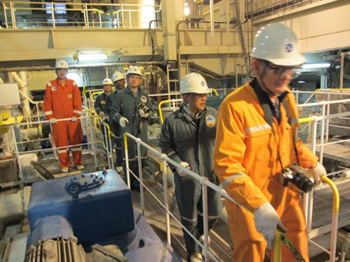
Members of the science party get a tour of the drilling operations.


Anniversary of 1st Deep Ocean DrillingApril 2, 2012
Today marked our first full day at sea on this historic ultra-deep ocean drilling and observatory installation expedition. We are all quite excited and prepared to take on the many challenges that will be involved.
Interestingly, today also marked another historic event in the history of scientific ocean drilling and our understanding of the Earth. It was on this day, 51 years ago on April 2nd 1961 that the very first deep ocean drilling expedition collected core samples confirming that the oceanic crust was composed of basalt (a volcanic rock). This was just one of many discoveries at the time that contributed to the development of the theory of plate tectonics.
I was surprised to learn that the shipboard historian on the expedition was none other than the very famous author, John Steinbeck, who later wrote an article about the adventure for LIFE Magazine.
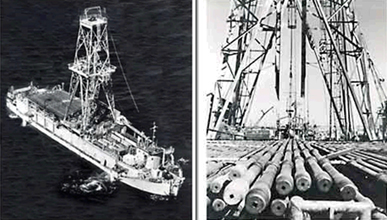
An overhead view of the CUSS 1, the first scientific deep ocean drilling vessel. It was converted from an old Navy barge. While it is small and simple compared to the Chikyu, some the technology developed for it use, including dynamic positioning (using steerable thrusters or propellers to stay in one spot), is still used on the Chikyu today. (US-NSF Photo)
There was even a short documentary made at the time (The First Deep Ocean Drilling Part I, Part II ) about the engineering challenges they faced drilling in water depths of 3500 m that were roughly 30 times deeper than the depths the industry was drilling at the time. They also sought to take core samples that were considerably longer and deeper than commonly collected and to collect subsurface temperature measurements.
The challenges that were overcome with their expedition are in many ways similar to those associated with the JFAST project. We too will be drilling in water depths (7000 m) that are considerably deeper than even deep water commercial drilling. In addition, while two boreholes have previously been drilled at similar water depths, they were only drilled and cored to ~15 m below the seafloor; we plan to go to ~ 1000 m below the seafloor like IODP expeditions in shallower water, collect long sections of core from the fault zone, and also install underground observatories to monitor temperature and pressure.
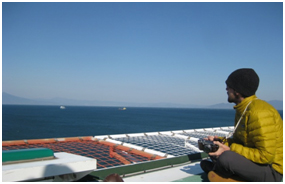
Patrick (perhaps) contemplating the journey ahead
The JFAST project is going to be difficult, but I, for one, am humbled by the achievements and scientific legacy of this first scientific ocean drilling expedition and those that followed. While we too will be using state-of-the-art technology and even some new technology specifically designed for this expedition, in many ways we will be using many of the same techniques that were used and developed by these early ocean drilling scientists and engineers.


清水港を出港して2日経ちましたApril 2, 2012
清水港を出港して2日経ちました。
今回の航海で、Expedition Project Managerとして乗船している江口です。
私の仕事は簡単に言うと、研究チーム(10カ国から28人乗船中)と、掘削オペレーションチームとの意思疎通をクリアにすること。それに、研究者達の船上、および下船後の研究の手伝いをすること。そして研究者達が幸せな(!)船上生活を送れるようにすることです。
清水でのポートコール中は、これまでの航海ではなかったほどのメディアの人々が取材にいらっしゃり、世の中の人がこの航海に寄せる期待(?)を、ひしひしと感じ、改めて気持ちが引き締まる思いでした。
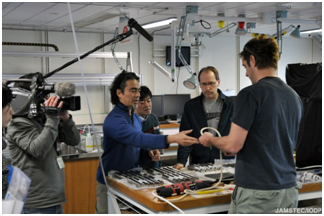
出航前、船上ラボでの取材の様子。今回設置する温度センサーを紹介しました。
右から、わたしと同じくExpedition Project ManagerのSean、首席研究者のFredとJim、そして江口です
この航海はいろんな意味で特殊ですが、中でも我々オペレーション側にとって大変だったのは、なによりも準備期間が短かったということです。(その科学的な理由は首席研究者のレポートに任せるとして)7000mの水深で、その海底下を1000m掘削するという計画を1年足らずで実現に持って行くというのは、並大抵の騒ぎではありませんでした(詳細は省きますが・・・)
昨日出港した時に、富士山が目の前にそびえていました。その富士山を見ていて気がついたのが、私たちは、なんと、この富士山の二倍の高さの距離までパイプを降ろして掘削するのだ!という事です。
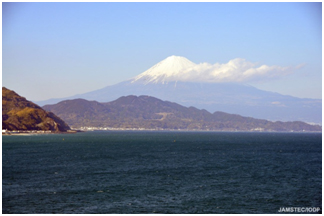
この富士山の二倍の高さの距離まで掘削するのだ!
現在、「ちきゅう」は目的地に向けて航行中です。乗船研究者達は船の生活に慣れ始めたところです。さて、この先どんな事が待ち構えているのでしょうか?
出来るだけ時間を見つけてレポートして行こうと思います!
Stay Tuned!!
Nobu Eguchi


Chikyu sets sailApril 1, 2012
Most of the international scientists participating in the JFAST expedition (IODP Expedition 343) arrived in Japan on the 29th of March, 2012, and after a night in Tokyo, made their way on the bullet train to the port of Shimizu the next day. There, we boarded the Chikyu and were introduced to our accommodation, the onboard facilities, and lots of staff of the ship. The facilities are really impressive and I hope to learn a lot about the procedures that are in place to handle and log core, as well as about all the other forms of data that will be recovered (such as geophysical logs). IODP has been doing this sort of work for a long time, and I think there are a lot of good lessons I can learn that I can apply in the next phase of drilling for the Alpine Fault ? Deep Fault Drilling Project (DFDP) in New Zealand.
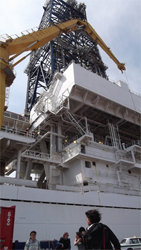
Scientists are dwarfed by the Chikyu’s drill derrick as they arrive and start to board.
In front is Francesca Remitti, from Italy.
The Chikyu stayed in port the next day, allowing some of us to explore the local area, and obtain last minute provisions for the next 54 days at sea. I managed to go for a last run on land this morning, through quaint Japanese streets and orange groves. I discovered a Buddist Zen Temple (Seikenji Temple) dating from 679AD, just up the hill that we went back to visit later. Something I was impressed by is that the locals sell the produce from their back gardens via ‘honesty box’ stalls outside their houses ? this is something we do in my home town in New Zealand as well!
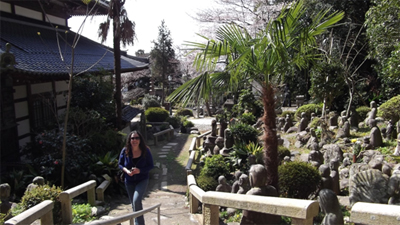
Monica Wolfson (USA) explores the grounds of Seikenji Temple, Shimizu.
Now, its just after 3pm on the 1st of April and the Chikyu has finally set sail. Everyone went out on deck to watch as we pulled away from the port in breezy but sunny conditions. Mt. Fuji was spectacularly visible on the skyline to the north as we sailed away. We’re presently steaming our way out through the harbour mouth and will then start to sail northeast towards the proposed drilling sites. The boat is beginning to sway gently so maybe we’ll all find out how we get on with motion sickness now. We start our shifts tonight, and I am scheduled to work midnight to midday, so I will soon be headed off to bed for a few hours of sleep.
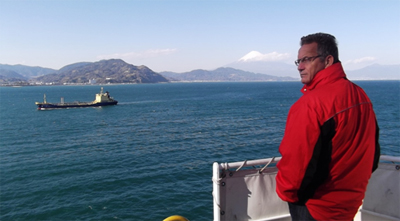
Jan Behrmann (Germany) looks pensively landward
as we steam out of port in the shadow of Mt. Fuji.

















